- acute triangle
- a triangle where all the angles are less than 90o
- adjacent leg
- the leg of the right triangle next to the reference angle
- altitude
- a line segment of a triangle connecting a vertex to the line containing the opposite side and perpendicular to that side
- altitude of a triangle
- a line segment drawn or dropped perpendicular from the vertex of a triangle to the line containing the opposite side, the height of the triangle
- angle Bisector
- a ray that divides an angle into two equal parts
- angle of depression
- an angle measured below a particular reference point (usually a line of sight)
- angle of elevation
- an angle measured above a particular reference point (usually a line of sight)
- apex
- the vertex of a pyramid that is opposite from the base of a pyramid
- apothem
- the perpendicular length from the center of a regular polygon to its edge
- arc
- a curved line that is a part of a circle, a part of the circumference of a circle
- arc length
- the measure of the distance along the curved line of the circle, a segment of the circumference
- area
- the number of square units required to cover a give flat surface
- axiom
- a statement that is accepted as true
- base
- the congruent polygons that are parallel to each other on the top and bottom of a prism
- bisect
- to divide into two equal parts; the dividing line is called a bisector
- central angle
- an angle that intersects a circle in two points and whose vertex is the center of the circle
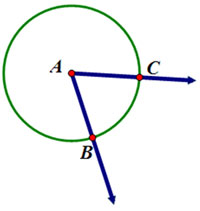
- chord
- a line segment with two endpoints that lie on a circle
- circumference
- the perimeter of a circle; C = 2πr or C = dπ where C = circumference, r = radius, and d = diameter
- composite figure
- a figure made from two or more geometric figures
- conjecture
- an educated guess; a sentence that is either true or not true
- conclusion
- the “q” part of the conditional statement following the word “then,” the part to be proved
- conditional statement
- a statement written in the form if “p” then “q”
- cone
- a three-dimensional figure that has one circular base and one vertex
- congruent
- figures have the same shape and size, angles and sides have the same measures
- congruent triangles
- triangles with corresponding sides of the same length and corresponding interior angles of the same measure
- conjecture
- a statement believed to be true requiring proof
- contrapositive statement
- a statement exchanging and negating the hypothesis and conclusion of the original statement
- converse statement
- a statement exchanging the hypothesis and the conclusion of the original statement
- corollary
- a statement that follows directly from a theorem; a mini-theorem
- corresponding parts
- sides and angles that match up and are the same size shape and measure (congruent)
- counterexample
- an example which proves a conjecture is false
- cross multiply
- products of the means and extremes
- cross-section
- the plane figure which results when a 3-dimensional solid is intersected by a plane
- cube
- a rectangular prism with all sides congruent and all faces squares
- cylinder
- a three-dimensional geometric figure that has two congruent, parallel, circular bases
- deductive reasoning
- reasoning that arrives at a conclusion using facts, definitions, theorems, postulates, or properties
- denominator
- the bottom number in a fraction
- diagonal
- a segment in the interior of a polygon that connects non-adjacent vertices
- diameter
- a line segment that passes through the center of a circle with both its endpoints lying on the circle or sphere
- dilation
- a transformation that enlarges or reduces a figure
- dimensions
- used to describe the size and shape of an object
- edge
- the intersection of faces in a three-dimensional figure
- enlargement
- the result of dilation with a scale factor greater than 1
- equiangular
- all the angles of the polygon are congruent or have equal measures
- equilateral
- all the sides of the polygon are the same length or have equal measures
- Euler's Formula
- the number of vertices plus the number of faces less the number of edges equals 2
- Euler's Theorem
- the relationship between the number of faces, edges, and vertices in a polyhedron: V − E + F = 2
- exterior angle
- extend each side of the regular polygon as shown below, no vertex will have more than one exterior angle
- face
- flat surface of a three-dimensional figure
- geometric properties
- attributes or characteristics of a geometric figure which are supported by definitions, postulates, or theorems
- great circles
- a circle on the surface of a sphere whose center is the center of the sphere
- height
- for a cylinder: the length of the segment perpendicular to both bases;
for a cone: the length of the segment perpendicular to the base and ending at the point of the cone
- hypotenuse
- the side opposite the right angle in a right triangle; it is the longest side of a right triangle
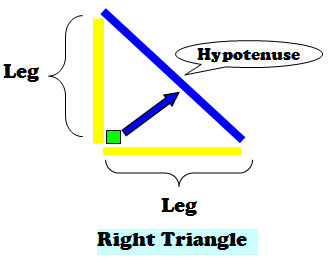
- hypothesis
- the “p” part of the conditional statement following the word “if,” the given information
- image
- a figure from a transformation
- included angle
- an angle between two adjacent sides of a polygon; the segments representing the adjacent sides are included in the rays that create the angle
- inductive reasoning
- reasoning that arrives at a conclusion by generalizing a statement from observing patterns
- inscribed angle
- an angle which intersects a circle in two points and whose vertex is on the circle
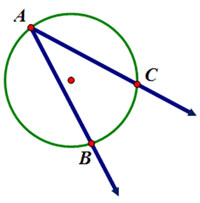
- inscribed polygon
- a polygon for which all of its vertices lie on a circle
- inscribed square
- a square whose vertices lie on a circle
- intercepted arc
- the arc of the circle which is in the interior of the inscribed angle
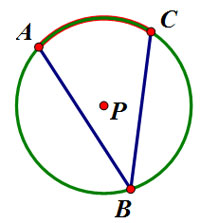
- interior angles
- angles located inside the triangle, one at each vertex
- inverse statement
- a statement negating both the hypothesis and conclusion of the original statement
- irregular polygon
- a polygon whose sides are not all congruent to each other
- isometric
- representation of 3-Dimensional figures so that three sides of the figure can be observed
- isosceles triangle
- a triangle in which two sides are of equal length
- justify
- to provide a valid reason, possibly using postulates, theorems, corollaries, or definitions
- lateral area
- the sides:
lateral surface of a cylinder rectangle
lateral surface of a cone circular section
- lateral edge
- intersecting edges of the lateral faces of a solid
- legs
- the sides adjacent to the right angle in a right triangle
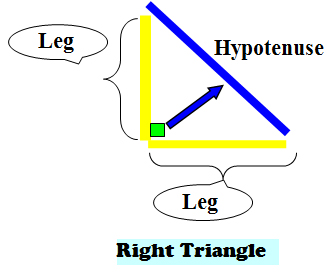
- line
- holds location and has no thickness, length or width; it has no measure in any direction
- line segment
- a part of one line with two endpoints and all the points in between
- linear pair
- an interior angle paired wtih an exterior angle sharing the same side
- median of a triangle
- a line segment with endpoints that are a vertex of a triangle and the midpoint of the opposite side
- minor arc
- the shortest distance from one point on the circumference to another point on the circumference
- multiple
- the product of a number and any integer
- negation
- a statement formed by inserting the word “not” to change the meaning of the hypothesis or the conclusion to its opposite meaning
- net
- a two-dimensional picture of a three-dimensional figure that can be folded to form the figure
- numerator
- the top number in a fraction
- oblique cone
- a cone in which the height is not perpendicular to the base
- oblique cylinder
- a cylinder in which the bases are not aligned
- oblique prism
- a prism in which the bases are not aligned properly
- obtuse triangle
- a triangle with one angle larger than 90o but less than 180o (an obtuse angle
- opposite leg
- the leg of the right triangle opposite from the reference angle
- orthographic
- representation of 3-Dimensional figures using 2-Dimensional perspectives such as the Front, Side, or Top View
- perfect square
- the product of a squared integer or an integer to the second power
- perpendicular
- two lines or line segments intersecting to form 90o angles
- plane
- has length and width, but no thickness or height; a flat surface that extends infinitely in all directions along its length and width
- point
- holds location and has no thickness, length or width; it has no measure in any direction
- point of tangency
- the point where a tangent line intersects a circle
- polygon
- a closed plane figure formed by three or more line segments intersecting at their endpoints
- polyhedron
- a solid figure whose sides are polygons
- postulate
- a statement that is accepted as true without proof
- pre-image
- the original image before a transformation
- prism
- 3-dimensional solid with 2 parallel and congruent bases named after the shape of the base
- proportional
- having a consistent ratio of all corresponding sides between two figures
- pyramid
- a three-dimensional figure with a polygon for a base and triangles for sides
- Pythagorean Theorem
- in a right triangle, where a and b are the lengths of the legs and c is the length of the hypotenuse, and a2 + b2 = c2
- Pythagorean Triple
- a set of three whole numbers that satisfy the Pythagorean Theorem
- radius
- the distance from the center of the circle to any point on the circle's circumference or for a regular polygon, the length from the center to a vertex
- ratio
- a fraction
- rate of change
- the ratio of the change in the output value and change in the input value of a function
- rectangular prism
- a three dimensional object with six faces that are rectangles
- reduction
- the result of dilation with a scale factor less than 1
- reference angle
- one of the two acute angles of a right triangle that is the reference point
- reflection
- a transformation from a figure flipped across a line
- regular polygon
- an enclosed figure with all angles and all sides congruent
- regular pyramid
- a polyhedron with a polygonal base and triangles for sides, the height intersects the base at a right angle and the vertex
- right angle
- an angle that has a measure of 90o
- right cone
- a three-dimensional figure that has one circular base, one vertex and the height intersects the base at a right angle
- right cylinder
- a three-dimensional geometric figure that has two congruent and parallel bases and the height is perpendicular to both bases
- right prism
- a polyhedron consisting of two parallel, congruent faces called bases
- right triangle
- a triangle containing one interior angle with a measure of 90o (i.e. a right angle)
- rotation
- an image is rotated or turned around a point
- scale factor
- a positive number which describes the size change from a geometric figure to its image
- scalene triangle
- a triangle in which all three sides of the triangle are of different lengths
- secant
- a line that intersects a circle in two points
- sector
- a region of a circle at the center outlined by two radii and an arc or a piece of the circumference
- segment
- a line with two endpoints
- segment of a circle
- the portion of a circle bounded by the circle and the chord connecting the endpoints of two radii of the circle
- semicircle
- half a circle
- semi-regular tessellation
- a tessellation formed when two or more regular polygons with identical vertices
- similar figures
- figures which are the same shape but not necessarily the same size; corresponding sides are proportional and corresponding angles are congruent
- slant height
- the distance from the apex of a cone or pyramid to the base along the lateral surface of the solid
- special right triangles
- right triangles with angle measures of
30o-60o-90o
or
45o-45o-90o
- sphere
- a three dimensional figure where all the points are equidistant from a given point
- straight angle
- an angle with a measure of 180o
- surface area
- the sum of the areas of all its faces
- supplementary angles
- the sum of two angles equal 1800
- symmetry
- exact correspondence from one side of a dividing line or plan to the opposite sideof form and constituent configuration on opposite sides of a dividing line or plane or about a center or an axis
- tangent
- a line that intersects a circle in exactly one point
- tessellate a plane
- cover a plane with geometric figures with “no gaps-no overlaps”
- tessellation
- a repeated pattern covering a plane without any gaps or overlaps
- theorem
- a statement which has been shown to be true
- tiling
- polygons fit together to cover a play without gaps or overlaps
- total surface area
- the sum of the areas of all its faces
- transformation
- a change in the size or position of a figure
- translation
- the figure slides along a straight line
- trapezoidal
- three-dimensional shape which has at least one trapezoid as a face
- truth value
- a statement can have a value of true or false
- vertex/vertices
- a point at which the rays of an angle meet; the point at which two sides of a polygon meet; or where two or more edges of a polyhedron meet
- volume
- the number of cubic units required to fill a 3-dimensional space









